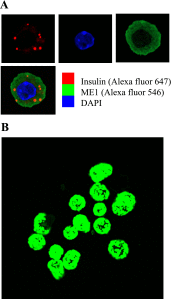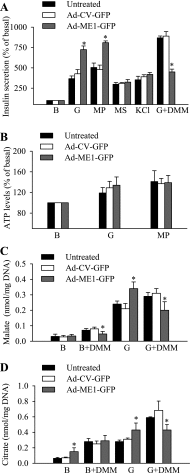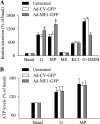Role for malic enzyme, pyruvate carboxylation, and mitochondrial malate import in glucose-stimulated insulin secretion
- PMID: 19293334
- PMCID: PMC2692397
- DOI: 10.1152/ajpendo.90836.2008
Role for malic enzyme, pyruvate carboxylation, and mitochondrial malate import in glucose-stimulated insulin secretion
Abstract
Pyruvate cycling has been implicated in glucose-stimulated insulin secretion (GSIS) from pancreatic beta-cells. The operation of some pyruvate cycling pathways is proposed to necessitate malate export from the mitochondria and NADP(+)-dependent decarboxylation of malate to pyruvate by cytosolic malic enzyme (ME1). Evidence in favor of and against a role of ME1 in GSIS has been presented by others using small interfering RNA-mediated suppression of ME1. ME1 was also proposed to account for methyl succinate-stimulated insulin secretion (MSSIS), which has been hypothesized to occur via succinate entry into the mitochondria in exchange for malate and subsequent malate conversion to pyruvate. In contrast to rat, mouse beta-cells lack ME1 activity, which was suggested to explain their lack of MSSIS. However, this hypothesis was not tested. In this report, we demonstrate that although adenoviral-mediated overexpression of ME1 greatly augments GSIS in rat insulinoma INS-1 832/13 cells, it does not restore MSSIS, nor does it significantly affect GSIS in mouse islets. The increase in GSIS following ME1 overexpression in INS-1 832/13 cells did not alter the ATP-to-ADP ratio but was accompanied by increases in malate and citrate levels. Increased malate and citrate levels were also observed after INS-1 832/13 cells were treated with the malate-permeable analog dimethyl malate. These data suggest that although ME1 overexpression augments anaplerosis and GSIS in INS-1 832/13 cells, it is not likely involved in MSSIS and GSIS in pancreatic islets.
Figures






Similar articles
-
Regulation of insulin secretion: role of mitochondrial signalling.Diabetologia. 2010 Jun;53(6):1019-32. doi: 10.1007/s00125-010-1685-0. Epub 2010 Mar 12. Diabetologia. 2010. PMID: 20225132 Free PMC article. Review.
-
The dicarboxylate carrier plays a role in mitochondrial malate transport and in the regulation of glucose-stimulated insulin secretion from rat pancreatic beta cells.Diabetologia. 2011 Jan;54(1):135-45. doi: 10.1007/s00125-010-1923-5. Epub 2010 Oct 15. Diabetologia. 2011. PMID: 20949348
-
A role for ATP-citrate lyase, malic enzyme, and pyruvate/citrate cycling in glucose-induced insulin secretion.J Biol Chem. 2007 Dec 7;282(49):35657-65. doi: 10.1074/jbc.M707294200. Epub 2007 Oct 10. J Biol Chem. 2007. PMID: 17928289
-
Feasibility of a mitochondrial pyruvate malate shuttle in pancreatic islets. Further implication of cytosolic NADPH in insulin secretion.J Biol Chem. 1995 Aug 25;270(34):20051-8. J Biol Chem. 1995. PMID: 7650022
-
Metabolic cycling in control of glucose-stimulated insulin secretion.Am J Physiol Endocrinol Metab. 2008 Dec;295(6):E1287-97. doi: 10.1152/ajpendo.90604.2008. Epub 2008 Aug 26. Am J Physiol Endocrinol Metab. 2008. PMID: 18728221 Free PMC article. Review.
Cited by
-
GWAS in people of Middle Eastern descent reveals a locus protective of kidney function-a cross-sectional study.BMC Med. 2022 Mar 1;20(1):76. doi: 10.1186/s12916-022-02267-7. BMC Med. 2022. PMID: 35227251 Free PMC article.
-
The pyruvate carboxylase-pyruvate dehydrogenase axis in islet pyruvate metabolism: Going round in circles?Islets. 2011 Nov-Dec;3(6):302-19. doi: 10.4161/isl.3.6.17806. Epub 2011 Nov 1. Islets. 2011. PMID: 21934355 Free PMC article. Review.
-
Regulation of insulin secretion: role of mitochondrial signalling.Diabetologia. 2010 Jun;53(6):1019-32. doi: 10.1007/s00125-010-1685-0. Epub 2010 Mar 12. Diabetologia. 2010. PMID: 20225132 Free PMC article. Review.
-
New views on the selection acting on genetic polymorphism in central metabolic genes.Ann N Y Acad Sci. 2017 Feb;1389(1):108-123. doi: 10.1111/nyas.13285. Epub 2016 Nov 10. Ann N Y Acad Sci. 2017. PMID: 27859384 Free PMC article. Review.
-
Plasma membrane electron transport in pancreatic β-cells is mediated in part by NQO1.Am J Physiol Endocrinol Metab. 2011 Jul;301(1):E113-21. doi: 10.1152/ajpendo.00673.2010. Epub 2011 Apr 19. Am J Physiol Endocrinol Metab. 2011. PMID: 21505151 Free PMC article.
References
-
- Antinozzi PA, Segall L, Prentki M, McGarry JD, Newgard CB. Molecular or pharmacologic perturbation of the link between glucose and lipid metabolism is without effect on glucose-stimulated insulin secretion. A re-evaluation of the long-chain acyl-CoA hypothesis. J Biol Chem 273: 16146–16154, 1998. - PubMed
-
- Berry MN The function of energy-dependent redox reactions in cell metabolism. FEBS Lett 117 Suppl: K106–K120, 1980. - PubMed
-
- Berry MN, Fanning DC, Grivell AR, Lewis SJ, Farrington CJ, Wallace PG. Evidence for several separate functional pools of NAD(H) within the cytoplasmic compartment of the hepatocyte. Biochem Soc Trans 8: 570, 1980. - PubMed
-
- Boucher A, Lu D, Burgess SC, Telemaque-Potts S, Jensen MV, Mulder H, Wang MY, Unger RH, Sherry AD, Newgard CB. Biochemical mechanism of lipid-induced impairment of glucose-stimulated insulin secretion and reversal with a malate analogue. J Biol Chem 279: 27263–27271, 2004. - PubMed
Publication types
MeSH terms
Substances
Grants and funding
LinkOut - more resources
Full Text Sources
Medical
Miscellaneous

